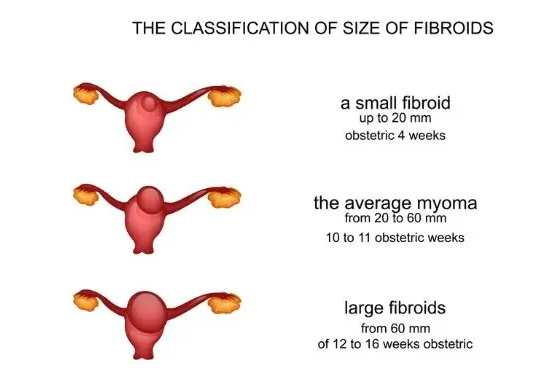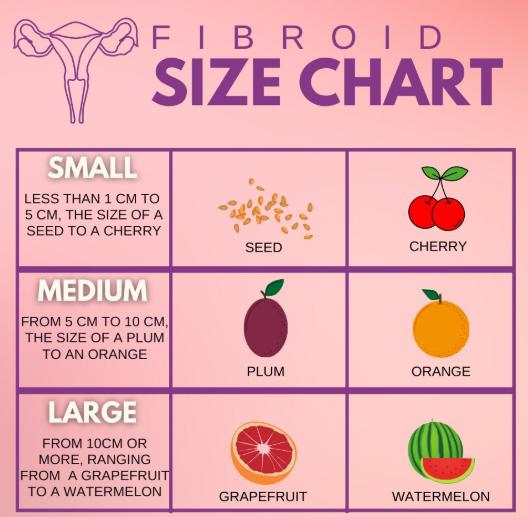Uterine fibroid size varies from being as small as a seed to as large as a melon, although multiple can develop inside and outside your uterus. A single fibroid may be less than an inch, but groups and clusters of fibroids can be much larger. Fibroids are commonly classified based on their dimensions due to their variations in size and type.
Consulting a fibroid specialist, regardless of size, is the best method of preventing fibroids from growing and causing more severe symptoms. At USA Fibroid Centers, our team of expert interventional radiologists specializes in diagnosing and treating fibroids with non-surgical, outpatient procedures designed to provide lasting relief and improve quality of life.
Fibroid Size Classifications
Fibroids can affect various parts of the body depending on their size, classification, and location.
Which Size of Fibroid is Normal?
The average uterine fibroid size ranges between 5 cm and 10 cm. Although size can affect the severity of symptoms, it is not the only factor determining what symptoms women with fibroids may experience.
Which Size of Fibroid Is Dangerous?
Uterine fibroid size alone does not always correlate directly with symptom severity; even small fibroids may cause significant issues depending on their location. However, some large to medium-sized fibroids can impact surrounding organs by expanding the abdominal area to resemble pregnancy, frequent urination, difficulty emptying the bladder, or constipation.
Our fibroid doctors use imaging studies, such as ultrasounds or MRIs, to accurately assess the fibroids’ size, number, and location to determine the most appropriate course of treatment for each patient. Schedule a consultation today to learn more about your treatment options.
Do Certain Fibroid Sizes Cause More Pain?
Fibroid-related pain can occur regardless of size, but larger fibroids are more likely to press against surrounding organs, leading to increased discomfort, cramping, and pelvic pressure. Even small fibroids can cause significant pain depending on their location within the uterus.
If left untreated, fibroid pain can worsen over time, especially if fibroids continue to grow. In some cases, large fibroids may rupture or degenerate, leading to severe pain and inflammation. Early treatment can help relieve pain and prevent further complications.
What Size Fibroid Needs To Be Removed?
If you’re wondering whether a fibroid needs to be removed, the answer depends on more than size. Fibroids can vary widely, from as small as a seed to as large as a melon, but their impact is influenced by their location and the symptoms they cause.
While fibroids may sometimes fluctuate in size, significant and consistent fibroid shrinkage without treatment is rare. Most fibroids do not shrink on their own, and waiting for them to do so is not a recommended management strategy.
Considerations for Fibroid Removal
- Persistence of Symptoms: Many women with fibroids continue experiencing symptoms despite changes in hormonal levels, such as those during menopause. Fibroids may not consistently respond to hormonal fluctuations in a way that leads to a significant and sustained reduction in size.
- Hormonal Influence: While hormonal factors can influence fibroid growth, hormone changes are not guaranteed to result in substantial and lasting shrinkage. The extent of this influence varies widely among individuals.
- Clinical Intervention: The medical community generally does not recommend relying on spontaneous fibroid shrinkage. Instead, fibroid specialists monitor their growth and recommend treatment based on their size, location, and symptoms rather than waiting for unpredictable changes.
While some women may experience fluctuations in fibroid size under certain circumstances, spontaneous shrinkage is not recommended as a primary management strategy. Regular medical monitoring and targeted interventions, when necessary, remain the standard practice for addressing fibroids and alleviating associated symptoms. Individual responses to fibroid growth and potential shrinkage are complex, requiring careful consideration and personalized medical attention.
If you’ve been diagnosed or are concerned you may have fibroids of any size, we recommend visiting a fibroid specialist to learn about your treatment options. The interventional radiologists at USA Fibroid Centers can adequately assess your health and provide the best treatment, no matter the size or weight of a fibroid.
SCHEDULE TO LEARN ABOUT YOUR OPTIONS
Can Uterine Fibroid Embolization Treat All Sizes?
Uterine Fibroid Embolization (UFE) is a highly effective and versatile non-surgical procedure for treating fibroids of diverse sizes and locations within the uterus. This treatment is a proven alternative to traditional surgical approaches, offering a range of benefits, including:
- Comprehensive Treatment: UFE targets uterine fibroids of any weight and size, from small nodules to large masses.
- Multi-Fibroid Approach: UFE is ideal for handling multiple fibroids. Unlike some surgical procedures that may include removing individual fibroids, UFE addresses the entire uterine blood supply while reducing the size and symptoms of all fibroids.
- Location Flexibility: The fibroid’s location within the uterus influences the treatment choice. UFE targets fibroids in challenging areas, including those near the uterine lining or on the outer surface.
- Preservation of Uterine Tissue: Unlike surgical procedures such as hysterectomy, which removes the entire uterus, UFE is a uterus-preserving technique. It allows women to retain their reproductive organs while effectively managing fibroid-related symptoms, which means your fertility stays intact and your hormones are not disrupted.
- Reduced Recovery Time: UFE is minimally invasive, introducing embolic agents into the blood vessels supplying the fibroids to block their blood flow. Compared to traditional surgeries, the procedure leads to a shorter recovery, with many women returning to their normal activities relatively quickly.
- Symptom Relief: Clinical studies and patient experiences consistently highlight the effectiveness of UFE in providing relief from symptoms such as heavy menstrual bleeding, pelvic pain, and pressure. The procedure addresses the root cause of these symptoms by inducing fibroid shrinkage.
UFE’s ability to treat various fibroid sizes and locations positions it as a valuable and patient-friendly choice in managing uterine fibroids.
Top-Rated Fibroid Treatment Near You
At USA Fibroid Centers, our doctors specialize in diagnosing and treating uterine fibroids of all sizes.
Visit our location page to find a center near you, call us at 855.615.2555, or schedule your initial appointment online today.


